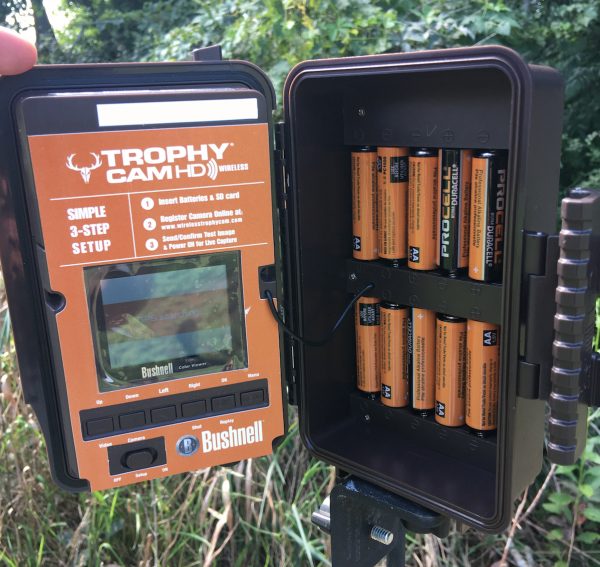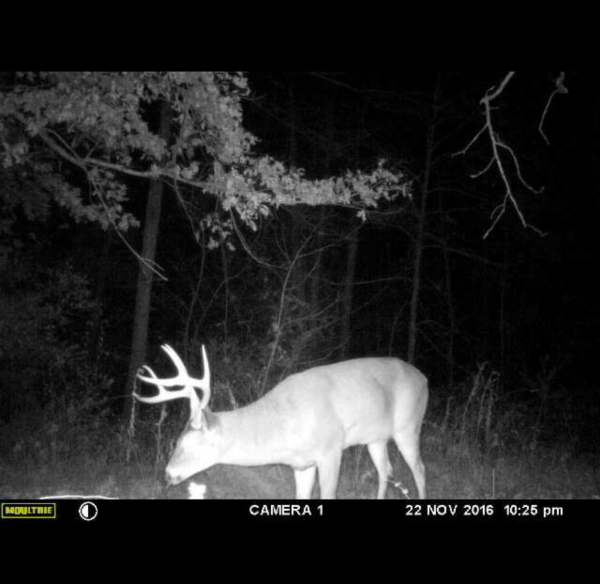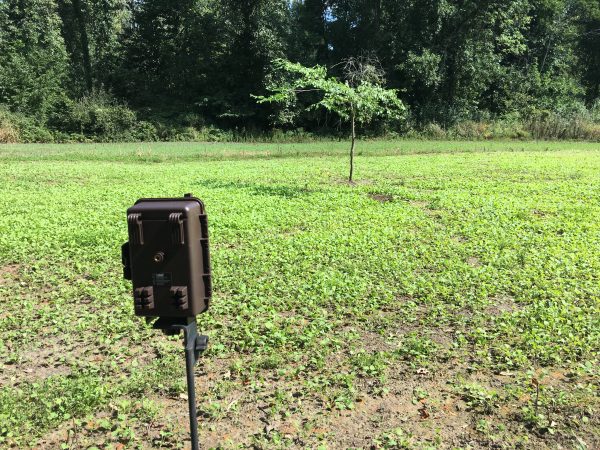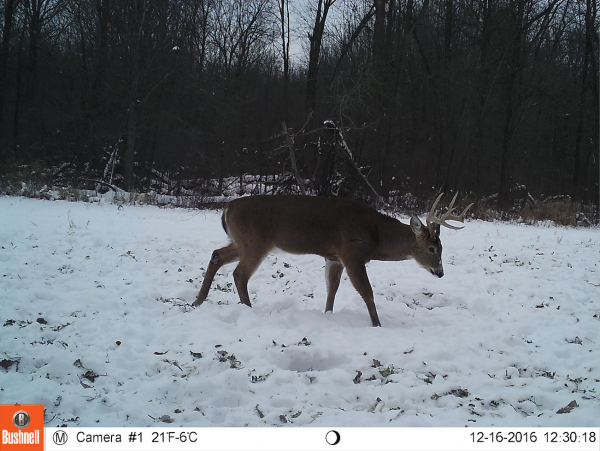
Almost all deer hunters these days use trail cameras to some degree, but the next generation of that technology – wireless cameras – are another story. Higher costs, required monthly data plans, and fair-chase questions have all led to a slower proliferation of this technology throughout the mainstream hunting population.
Last year, I was curious to find out for myself exactly what these wireless cams were all about, so in late summer I got my hands on two different models and set them out for use during the 2016 season. So for those of you curious about this “next big thing” in the world of cameras, here’s what I learned, what I liked and didn’t, and how I think I might or might not use them in the future.
The Cameras
I tried two different models of wireless cameras last year. One, provided by Bushnell, was the Trophy Cam HD Aggressor Wireless. The other option I picked up was a Moultrie Mobile Field Modem paired with their A-30 Game Camera. These two options were quite different.
First off, the Bushnell model. The Aggressor Wireless is a single self-contained unit and what I liked about it most was the ease of use. There was a simple set of instructions that led me through how to set up my account, sign up for a data plan, pair it with my camera and then set it up in the field. Bushnell offers several different data plans at varying rates – their cheapest, $9.99/month, gets you 1,500 thumbnails and for another $10/month you can double that to 3,000. Once I was signed up for my plan, I took the camera into the field, entered my email address for photo delivery, flipped it to “On” and it got to work. From this point on, as I’ve experienced with other Bushnell cameras, it was off to the races and had no tech-difficulties or failures. Photo quality, settings, etc were all on par with other Bushnell cameras. One thing I did notice though was that once the temperatures got lower and deer were in my food plot for very long periods of time (taking and sending lots of photos), my batteries drained pretty quickly. A set of batteries lasted about 4-6 weeks earlier in the season, but by late season it was more like 2-3 weeks.
Now to the Moultrie. Different than the Bushnell, the Moultrie set-up required two different units in use together – a modem and a camera – which are connected by a USB cord. This can be an asset, as you’re able to move your modem around and pair it with different Moultrie cameras you might have. But it also caused my biggest challenge I had with this camera. During the initial set-up process, after connecting the camera to the modem, I had some issues confirming it was paired and working, and getting it to properly take and send test images. This led to a good hour of questioning how I set it up, re-doing the whole thing and trying again over and over. This could have been user-error, I’m not sure. Either way though, eventually test images did come through and I was able to confirm the camera and modem were paired and working properly. I just cussed a lot in the process. Similar to the Bushnell, the Moultrie Modem had a set of instructions I followed to set up my account and sign up for a plan – which cost me $14.99/month. That said, once the Moultrie was set-up, I had no further challenges and it consistently took quality photos and set them my way. The camera I paired my mobile modem with was one of their cheaper models, so I could have gotten better photo quality/features if I’d wanted – but what I had was perfectly acceptable for my use. No complaints on that front.
All that said, both wireless camera options worked well and I could live with either one. But if I had to choose, the Bushnell would come out on top because of it’s slight advantage in ease of set-up and management. The Moultrie though did come in at a much lower price-point – $200 modem + $70 camera, compared to the typical $400 price-point for the Bushnell.
(Note: I did just find that Amazon is selling the Bushnell model for a significant discount)
One final note on costs. While I can see having a wireless camera or two, it still seems cost-prohibitive to have a whole bunch, along with all those data plans. For the time being, the vast majority of my cameras will continue to be traditional models.
Use-cases & Utility
The real question I had at the beginning of the 2016 season wasn’t so much which wireless trail camera I’d like most, but rather how much would I like any wireless camera at all. Would the increased cost and set-up challenges be worth it? Is the benefit of wireless photo transfer all that helpful?
The short answer is yes and yes. I found the wireless technology extremely useful, convenient, exciting and as I’m sure you can imagine – addicting.
I had two main use-cases for these wireless cameras. First, one of these units was going to be down on my Southern Ohio property which I can’t travel to often. By having a wireless camera in place, my hope was that I’d be able to keep tabs on daylight activity and better be able to determine when to make the 4.5 hour drive down to hunt there. I usually plan an opening weekend hunt, a potential mid-October hunt if good weather conditions are present, and then a longer rut-hunt. But this past season I decided to let the cameras determine when to make those trips. If daylight activity picked up on camera, it would be very clear and timely call-to-action. If not, I’d stay home until better conditions were present. This, in concept, makes a lot of sense. Unfortunately, we just never did get the bump in daylight activity I was hoping for down on that property, as deer activity in general last year suffered across the board. So, while I never did get to use my wireless data as a reason to make the drive, I’m sure it can and will play that purpose in future years.
The second use-case was on a much more local level, as I had my other wireless camera placed on a close-to-home Michigan property, overlooking a Winter Greens and Whitetail Oats Plus food plot I had planted in the core of this farm. I traditionally try to keep my human pressure in this area very low until the rut. I might hunt once early in the season and then not again until November. That is, unless trail camera intel tells me to do otherwise. To check trail cameras back there though, I’d have to drive my ATV back into this sensitive core area and inevitably educate deer to my presence. My goal this past season was to let my wireless trail camera do that work and allow me to stay 100% out of the area, yet still have up-to-date intel on when to move in for a strike.
This worked out wonderfully. As I was able to keep pressure in this area almost at zero, and only after I got daylight pictures of my top buck did I move in. I never did catch up to him in that area, but the reduced pressure and more calculated strikes did seem to have a positive impact – as the mature buck in question moved in daylight in this area much more than I’ve traditionally seen from other bucks during past years. My smarter strikes and reduced trail camera pressure, I’m convinced, did make a difference.
Fair-chase questions
Finally this brings me to one of the main questions I had about wireless cameras before I used one. Were there ethical or fair-chase issues with using this kind of technology? How much technology is too much?
After thinking about this quite a bit, I’ve realized I cannot answer those questions for anyone else but myself. We each have to draw our own line in the sand. But I do think it’s important to have a line, each of us, and for that line to be well thought out.
For me personally, I do see situations in which the use of wireless cameras or something similar could provide a level of advantage that I would deem unfair or excessive. For me that line is when it comes to real-time data.
For example, consider a hypothetical hunting scenario during firearm season, with a wireless camera set over a food plot. To use real-time data, lets say a photo or video of a buck on that food plot right now, and then stalk over and shoot that buck because I knew he was there right now – that would be an over-reach of technology and crossing of the fair-chase line, in my opinion.
So for me personally, I’ve chosen not to use cameras in that manner. If I were to receive current pictures of deer in a huntable location, I would not act on them. If the data was a half a day or older though, it would seem fair-game – as that deer is obviously not still in that exact place now and I could have acquired similar data from a camera I walked up to check physically. It’s a small distinction, but it’s the line I’ve drawn and currently feel comfortable with. Yours or someone else’s might be different.
Final Thoughts
Having now used wireless cameras for a full season, I can say without a doubt that they have tremendous utility. They’re a god-send for those hunting locations far from home, they’re terrific for keeping pressure low in important parts of your property, and they’re just plain fun. In fact, my wireless cameras proved to be one of my best tools for waking up on time in the morning. Rather than hitting the alarm and rolling back over for a few more minutes of sleep, I found that I’d be more excited to grab my phone and check what pictures came in over night!
That said, if you’re interested in wireless camera technology, give it a try. It can definitely help from a hunting perspective. But I’d also encourage you to do yourself the favor of thinking about the implications of this technology. Think ahead to what you might feel is right or wrong and draw that line for yourself.
Technology like this will continue to advance, and it will be incumbent on us as hunters to be thoughtful about how, when and why we use it.







